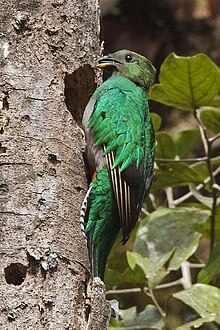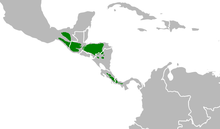Resplendent Quetzal
| Resplendent quetzal | |
|---|---|
 |
|
| A male | |
 |
|
| Female at nest hole | |
| Scientific classification | |
| Kingdom: | Animalia |
| Phylum: | Chordata |
| Class: | Aves |
| Order: | Trogoniformes |
| Family: | Trogonidae |
| Genus: | Pharomachrus |
| Species: | P. mocinno |
| Binomial name | |
|
Pharomachrus mocinno La Llave, 1832 |
|
| Subspecies | |
|
P. m. costaricensis |
|
 |
|
| Range of P. mocinno | |
P. m. costaricensis
P. m. mocinno
The resplendent quetzal (pronunciation: /ˈkɛtsəl/) (Pharomachrus mocinno) is a bird in the trogon family. It is found from Chiapas, Mexico to western Panama (unlike the other quetzals of the genus Pharomachrus, which are found in South America and eastern Panama). It is well-known for its colorful plumage. There are two subspecies, P. m. mocinno and P. m. costaricensis.
This quetzal plays an important role in Mesoamerican mythologies. The resplendent quetzal is Guatemala's national bird, and an image of it is on the flag and coat of arms of Guatemala. It is also the name of the local currency (abbreviation GTQ).
The resplendent quetzal was first described by Mexican naturalist Pablo de La Llave in 1832. It is one of five species of the genus Pharomachrus known as quetzals. The term "quetzal" was originally used for just this species, but is now applied to all members of the genera Pharomachrus and Euptilotis.
Two subspecies are recognised, P. m. mocinno and P. m. costaricensis. The epithet mocinno is Llave's Latinization of the name of the biologist J. M. Mociño, a mentor of his. (It is sometimes spelled mocino, but "ñ" was formerly spelled "nn" in Spanish, so the spelling with "nn" is justified and in any case now official.)
...
Wikipedia

